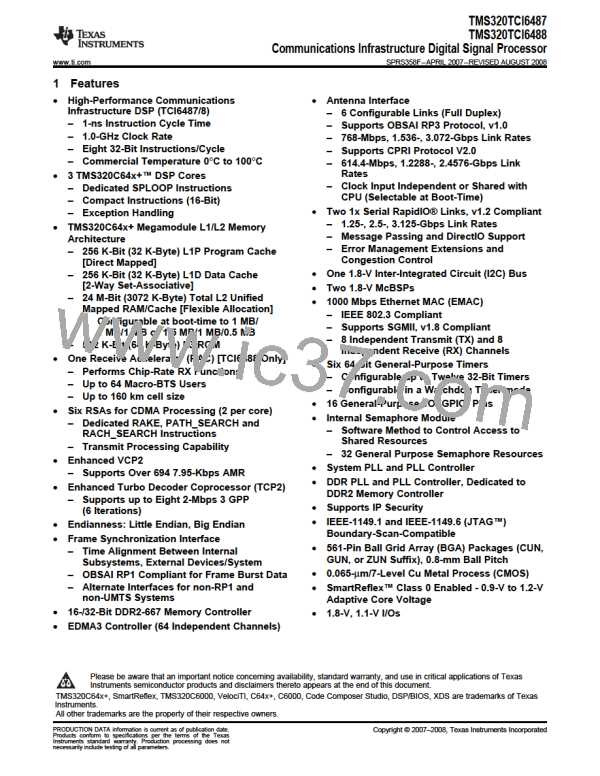TMS320TCI6487
TMS320TCI6488
Communications Infrastructure Digital Signal Processor
SPRS358F–APRIL 2007–REVISED AUGUST 2008
www.ti.com
4 System Interconnect
On the TCI6487/8 device, the C64x+ Megamodule, the EDMA3 transfer controllers, and the system
peripherals are interconnected through two switch fabrics. The switch fabrics allow for low-latency,
concurrent data transfers between master peripherals and slave peripherals. Through a switch fabric the
CPU can send data to the Viterbi co-processor (VCP2) without affecting a data transfer through the RAC
and the DDR2 memory controller. The switch fabrics also allow for seamless arbitration between the
system masters when accessing system slaves.
4.1 Internal Buses, Switch Fabrics, and Bridges/Gaskets
Two types of buses exist in the TCI6487/8 device: data buses and configuration buses. Some TCI6487/8
peripherals have both a data bus and a configuration bus interface, while others only have one type of
interface. Furthermore, the bus interface width and speed varies from peripheral to peripheral.
Configuration buses are mainly used to access the register space of a peripheral and the data buses are
used mainly for data transfers. However, in some cases, the configuration bus is also used to transfer
data. For example, data is transferred to the VCP2 and TCP2 via their configuration bus interface.
Similarly, the data bus can also be used to access the register space of a peripheral. For example, the
DDR2 memory controller registers are accessed through their data bus interface.
The C64x+ megamodule, the EDMA3 traffic controllers, and the various system peripherals can be
classified into two categories: masters and slaves. Masters are capable of initiating read and write
transfers in the system and do not rely on the EDMA3 for their data transfers. Slaves on the other hand
rely on the EDMA3 to perform transfers to and from them. Examples of masters include the EDMA3 traffic
controllers, SRIO and EMAC. Examples of slaves include the McBSP and I2C.
The TCI6487/8 device contains two switch fabrics through which masters and slaves communicate. The
data switch fabric, known as the data switched central resource (SCR), is a high-throughput interconnect
mainly used to move data across the system ( for more information, see Section 4.3). The data SCR
connects masters to slaves via 128-bit data buses (SCR B) and 64-bit data buses (SCR A) running at a
CPU/3 frequency (CPU/3 is generated from PLL1 controller). Peripherals that have a 128-bit data bus
interface running at this speed can connect directly to the data SCR; other peripherals require a bridge.
The configuration switch fabric, also known as the configuration switch central resource (SCR) is mainly
used by the C64x+ Megamodule to access peripheral registers (for more information, see Section 4.4).
The configuration SCR connects C64x+ Megamodule to slaves via 32-bit configuration buses running at a
CPU/3 frequency (CPU/3 is generated from PLL1 controller). As with the data SCR, some peripherals
require the use of a bridge to interface to the configuration SCR. Note that the data SCR also connects to
the configuration SCR.
Bridges and gaskets are required to perform a variety of functions. For the purpose of this document,
bridges and gaskets can be considered as identical. Within the switch fabric infrastructure, gaskets are
simpler than bridges in that they only modify control signals to convert protocols. Bridges perform a variety
of functions:
•
•
•
Conversion between configuration bus and data bus.
Width conversion between peripheral bus width and SCR bus width.
Frequency conversion between peripheral bus frequency and SCR bus frequency.
For more information on the common bus architecture and its throughput in the TCI6487/8 device, see the
TMS320TCI6487/8 Common Bus Architecture Throughput application report (literature number SPRAAN7)
and the TMS320TCI6487/8 Module Throughput application report (literature number SPRAAN6).
52
System Interconnect
Submit Documentation Feedback

 TI [ TEXAS INSTRUMENTS ]
TI [ TEXAS INSTRUMENTS ]